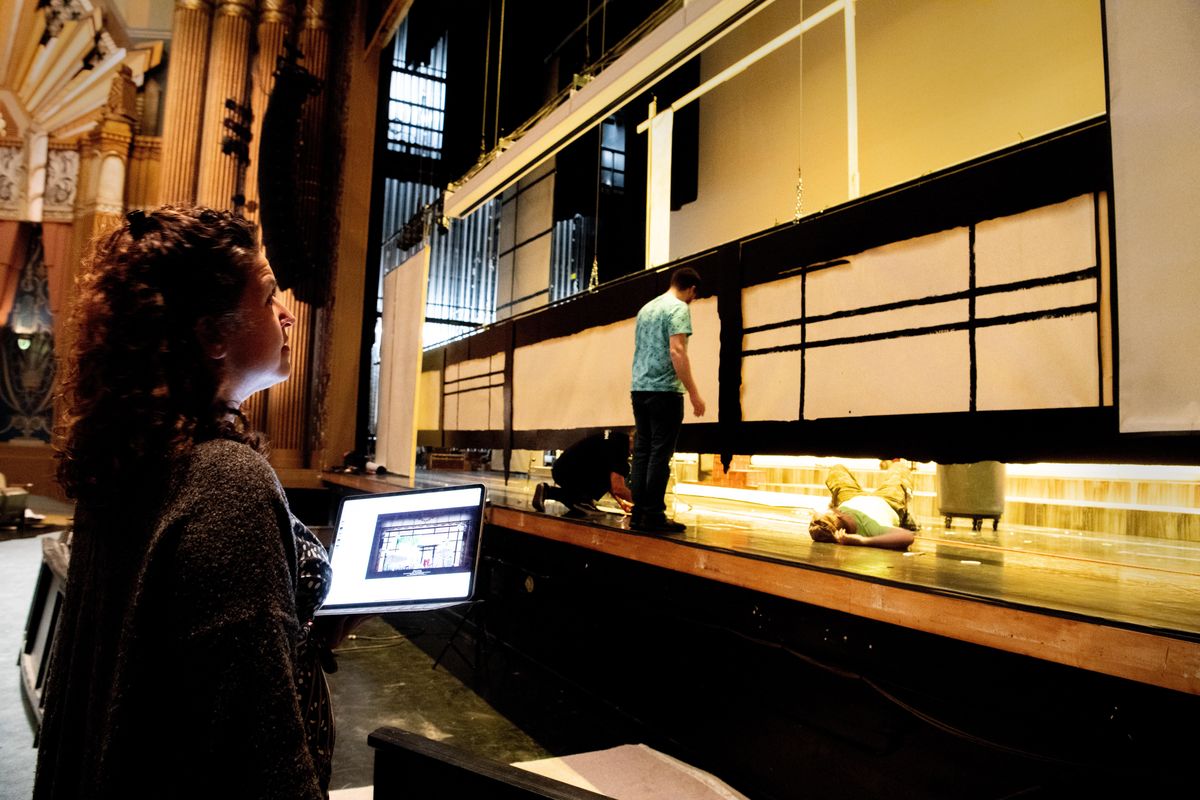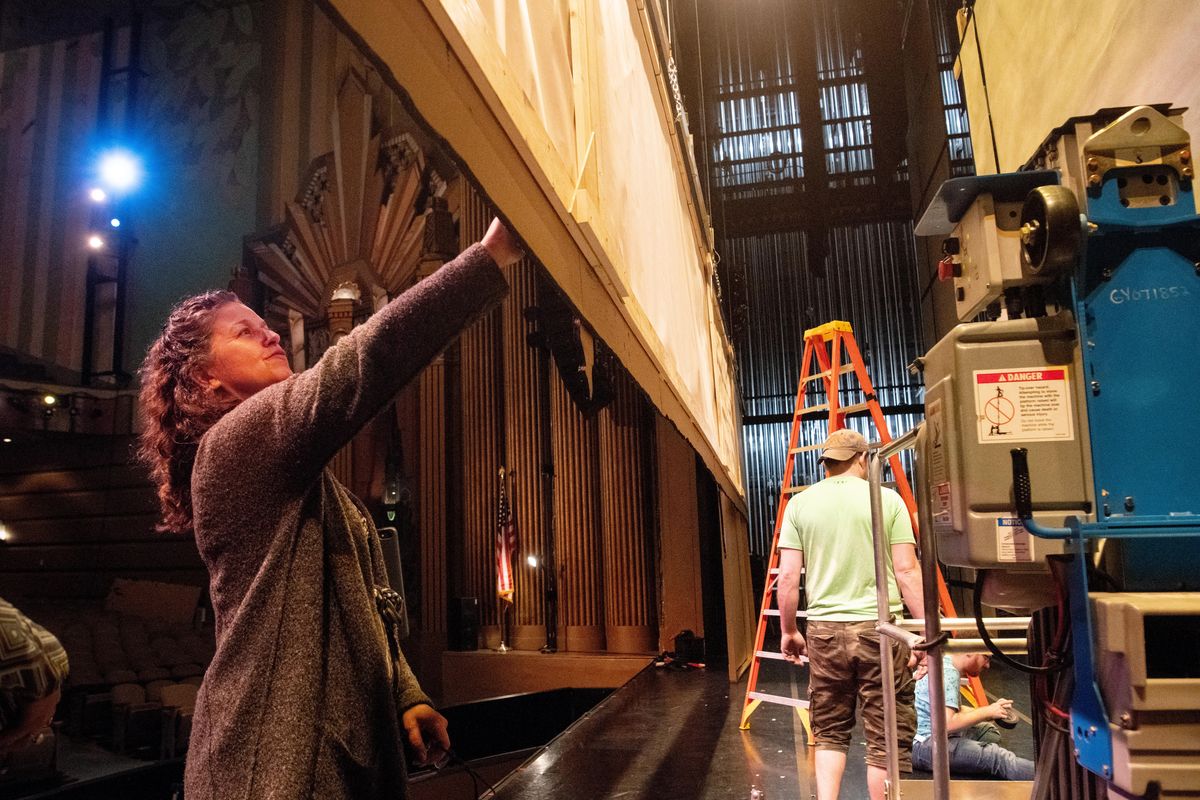Paper by design: ‘Madame Butterfly’ stage director Fenlon Lamb is familiar with many aspects of opera, including design

One of the fascinating aspects of Inland Northwest Opera’s “Madame Butterfly,” at Martin Woldson Theater at the Fox on Friday and Sunday, is that the set is made of paper. Stage director Fenlon Lamb, a friendly and outgoing former opera singer and actress who now directs and produces productions, discussed the paper by design on Tuesday afternoon inside the theater:
It’s so interesting that “Madame Butterfly’s” set is made entirely of paper.
We started it and thought, “This has worked in several operas, but can it really work in one as large as ‘Madame Butterfly’?” The paper medium gives you a real feel – the audience can feel it. Not only can they feel the emotions from the singers with these amazing voices and the great acting and the beautiful music from the pit, but then the set becomes part of that atmosphere, and it helps everybody tell the story together.
Using paper is not as expensive, but it’s still not cheap, correct? It seems as if there is flexibility and creativity, too.
Absolutely. It’s one of the things that we as a company at Papermoon Opera Productions and our designers saw. We like to think outside the box, and with paper we have this flexibility and playfulness and fun with the set design and the whole atmosphere. It’s still very large, but you get this lighter weight now that is a little more ephemeral, which is just like theater – it’s fleeting.
How long does it take for load-in to breakdown and loading out?
It depends. It can be easier than larger sets. These travel in one large crate. This set was actually built in Spokane in collaboration with Inland Northwest Opera. My “Hansel and Gretel” set travels in a 5-by-10-foot trailer and goes up in two hours. The Fox Theater is a fabulous and great theater, so we couldn’t just put in a small piece. This is taking a little longer, but it is worth it in the end.

You started out as an opera singer and actress. Why the transition to directing and producing? You obviously love the profession.
The production end of things hasn’t come easily. When I used to sing, it was one role, and I would do the research for the one role in telling the story. Being able to come back out and get the bigger picture, it was something that my friends and mentors understood would be a good role for me. I started directing small productions and realized that this was a good fit for me.
It helps because I’ve been up there and understand. People will say, “Oh, singers, they’re so emotional.” And I’m like, “Yeah, absolutely! I get it! They’re up there pouring their souls out. And we’re here to support that process and make it as easy as possible for them to do their best work because we’ve done our best work.
How fragile are the paper sets? Have they or the paper costumes ever ripped during a performance?
The costumes here are fabric because kimonos are difficult to create in paper, and we didn’t want to take that risk. With paper sets, the back end of things is so much easier. “Oh, that’s too long? Cut it. That ripped? Tape it.” But we are very careful because we want the sets to last, and they do last. Paper is much more durable than you might think – it’s quite a heavy stock.
How many paper set productions have you created?
This is by far the biggest so far. We’ve done “Hansel and Gretel” and “La Boheme.” We had “Juliet Letters,” which I turned into opera vignettes. It’s an Elvis Costello piece with string quartet. It’s very onsite friendly. “Madame Butterfly” is the largest paper set production so far, but we have “Don Giovanni” coming up, and that will probably be larger.
We’re going to create paper costumes for it, which will really help convey the story well. When people ask me what is my favorite opera, I tell them that it’s the one I’m involved with now because I’m so involved with it at that moment.
Have you ever directed or produced an opera in which you also were a performer?
You caught me! So when I was first making the switch over, there were some things where I thought that I could do everything. I did “Carmen” – I sang “Carmen,” I produced it, I didn’t have a team then, so I did costumes, I did props, I did everything.
I directed it when I wasn’t onstage. It was at this tiny festival in Bar Harbour, Maine, and I will never, ever do that again. It was the stupidest thing I have ever done! There are pictures of me after, and I just look half dead. I learned my lesson. It’s fun, right?
Is the opera world fairly small?
Yes … everybody knows everybody. Maybe you haven’t met them yet, but you know their name and where they worked. Maybe you’ve crossed paths, but you haven’t officially met yet.
Are there any productions on your wish list?
Yes, I would love to do a “Magic Flute” in paper. We did one, but it wasn’t in paper – we weren’t working in paper yet as much. I’d love to do a “Marriage in Figaro” in paper.
I was actually listening to “The Queen of the Night’s Vengeance Aria” while getting ready this morning.
Look at you gettin’ it … getting your “Queen of the Night’s Vengeance Aria” on! “The Magic Flute” works really well in paper, and we actually had her character dressed in garbage bags. It was shiny on this huge ground. So it’s not just paper that we use – it’s also other found items and alternative mediums.
In this day and age, people are very environmentally conscious. Is that part of the reason for paper sets?
Yes, it is a smaller footprint in every way – shipping, all aspects. It’s recyclable at the end of the day if we decide that we don’t want it. All the excess materials are recyclable. I have a “Carmen” set in which I literally fit all the rolls of paper in my mother’s Honda Fit. If that’s not ecologically sound, I don’t know what is.
What are you looking forward to most this weekend with the two performances?
I really hope that the audiences will be wowed by the size of the sets, by the craftsmanship. This is an amazing cast, and they have been a joy to work with on “Madame Butterfly.” I’m very thankful for the casting and crew, and, as a sidebar, maestro Dean Williamson was my coach at Seattle Opera when I was there as a young artist, so I’m just so excited to bring all of this together to Spokane.